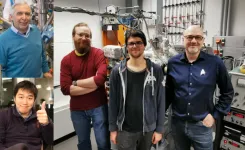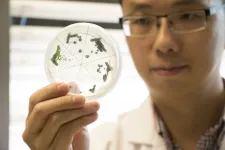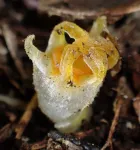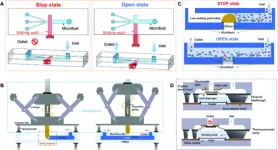(Press-News.org) Textbooks will tell you that in dividing cells, the production of new DNA peaks during the S-phase, while production of other macromolecules, such as proteins, lipids, and polysaccharides, continues at more or less the same level. Molecular biologists at the University of Groningen, led by professor Matthias Heinemann, have now discovered that this is not true: protein synthesis shows two peaks, and lipid synthesis peaks once. These shifts could explain the metabolic oscillations that lead up to cell division, which the group has discovered previously. Their new results were published in Nature Metabolism on 27 February.
Every dividing eukaryotic cell passes through the cell cycle: from a growth phase (G1) to a phase with synthesis of new DNA (S), a gap phase (G2), and finally a phase with cell division through mitosis (M). Scholarly texts on cell division will tell you that apart from the synthesis of DNA, all other molecules in the cell, such as proteins, lipids, and polysaccharides, are produced at a more or less constant rate throughout all cell cycle phases.
Dynamic measurements
Seven years ago, Matthias Heinemann and his group described oscillations in cell metabolism, which appeared to orchestrate the process of eukaryotic cell division. His team has now studied the metabolism in more detail and measured the rate at which proteins, lipids, and polysaccharides are produced during the cell cycle. And they discovered that the textbooks are wrong.
‘We have used dynamic microscopic measurements in single cells to show how the production of different macromolecules peaks at different times,’ explains Heinemann. The basic rate of protein synthesis peaked during the G1 phase, subsided in the S phase, and peaked again in the second half of the cell cycle. ‘We also found that synthesis of both lipids and polysaccharides, the building blocks for the cell wall, peaks only once: also in the second half.’
Building blocks
To determine the protein synthesis rate, the scientists used an established method of monitoring fluorescent proteins. They also devised a second, more sophisticated method, through which they could validate that protein production appeared to follow the two-wave pattern. ‘We had to develop this second method because our results were going against what we and everybody else knew about cell cycle metabolism,’ says Vakil Takhaveev, the first author of the paper. ‘In this novel method, we probed how sensitive a cell is to an inhibitor of protein biosynthesis at each moment of the cell cycle. It turned out that this sensitivity has peaks at different phases of the cell cycle.’
In their Nature Metabolism paper, Heinemann and his team show that the different building blocks for cells are not produced at the same time. Moreover, the researchers showed that the entire central metabolism has to change to satisfy this temporally segregated production of building blocks. For example, they found that the rate of glucose consumption, ethanol excretion, and respiration are allocated to specific phases of the cell cycle.
Interestingly, these new measurements concur with their earlier findings, explains Heinemann: ‘The cell must activate different biosynthetic pathways to produce amino acids or lipids. This produces changes in metabolite flows and that explains why we previously found metabolic oscillations during cell division.’ However, this leaves the question as to how exactly this happens and why. ‘At the moment, we can only speculate,’ says Heinemann. ‘One aspect is that if a cell simply grows, all building blocks are required at the same time. But during division, the situation is more complex. It might well be that the sequence of production can help the cell with division.’
Cancer and aging
Osmotic pressure could be the key to that. ‘Think about blowing up a balloon. At first, you need really high pressure, but once it starts to expand, a lower pressure is enough. Maybe the cell first produces a lot of proteins to increase osmotic pressure inside the cell, which could help in splitting off the daughter cell,’ says Heinemann. ‘Again, this is just speculation, but I do feel that there is a biophysical reason behind the patterns that we observed.’
He will pursue these ideas and search for the regulating mechanisms that are responsible for the different phases in the synthesis of cellular building blocks. ‘We don’t know yet how this works, but it would be extremely interesting to find out and to see how these regulatory systems might be perturbed.’ The current findings and future work are necessary for the fundamental understanding of cellular physiology and will eventually help us to tackle cancer and aging.
Reference: Vakil Takhaveev, Serdar Özsezen, Edward N. Smith, Andre J. Zylstra, Marten L. Chaillet, Haoqi Chen, Alexandros Papagiannakis, Andreas Milias-Argeitis and Matthias Heinemann: Temporal segregation of biosynthetic processes is responsible for metabolic oscillations during the budding yeast cell cycle. Nature Metabolism, 27 February 2023.
END
Cells avoid multitasking
Essential biochemical reactions are found to be separated in time
2023-02-27
ELSE PRESS RELEASES FROM THIS DATE:
Consulting Dr. YouTube: How digital misinformation may keep you from a good night’s sleep
2023-02-27
More than 60% of adults in the United States report accessing the Internet for health-related questions. Social media and content platforms like YouTube offer a vast wealth of content on sleep health, from tips on how to get a good night's sleep to managing sleep disorders and insomnia. A new study from researchers at Brigham and Women’s Hospital, a founding member of the Mass General Brigham healthcare system, identifies an alarming amount of medical misinformation in videos about sleep disorders on YouTube. Researchers identified that “popular” videos created by bloggers garnered significantly more views than expert-led videos and contained ...
New method for the detection of RNA viruses such as SARS-CoV-2
2023-02-27
Experts from the University of Barcelona, the Institute for Advanced Chemistry of Catalonia (IQAC-CSIC), the Institute of Microelectronics of Barcelona (IMB-CNM-CSIC) and the Aragon Nanoscience and Materials Institute of Aragon (INMA) —a joint institute of the CSIC and the University of Zaragoza— have developed a new method to detect RNA viruses based on the triplex-forming probe technology. This innovative methodology opens up new options for detecting viruses such as SARS-CoV-2, the influenza A virus (H1N1) or the respiratory syncytial virus (RSV), a pathogen that ...
Chaos on the nanometer scale
2023-02-27
Chaotic behavior is typically known from large systems: for example, from weather, from asteroids in space that are simultaneously attracted by several large celestial bodies, or from swinging pendulums that are coupled together. On the atomic scale, however, one does normally not encounter chaos – other effects predominate. Now, for the first time, scientists at TU Wien have been able to detect clear indications of chaos on the nanometer scale – in chemical reactions on tiny rhodium crystals. The results have been published in the journal ...
Real or fake text? We can learn to spot the difference
2023-02-27
The most recent generation of chatbots has surfaced longstanding concerns about the growing sophistication and accessibility of artificial intelligence.
Fears about the integrity of the job market — from the creative economy to the managerial class — have spread to the classroom as educators rethink learning in the wake of ChatGPT.
Yet while apprehensions about employment and schools dominate headlines, the truth is that the effects of large-scale language models such as ChatGPT will touch virtually every corner of our lives. ...
Adverse Pregnancy Outcomes May Help Identify Future Heart Disease Risk
2023-02-27
(Boston)—Many pregnancy complications are associated with future heart disease. Such complications include gestational diabetes, preterm birth, fetal growth restriction and hypertensive disorders of pregnancy (gestational hypertension, preeclampsia and related disorders), and together they are referred to as adverse pregnancy outcomes (APOs). Although APOs are recognized as a useful way to identify individuals with increased risk for future heart disease, it is not known how often APOs occur before traditional heart ...
LSU Health New Orleans pain protocol eliminates need for opioids following knee replacement in most patients
2023-02-27
New Orleans, LA – A study led by Vinod Dasa, MD, Professor of Orthopaedics at LSU Health New Orleans School of Medicine, reports that a novel surgical pain management strategy following total knee arthroplasty (TKA), or total knee replacement, provided pain relief without opioids. The researchers also found that changing prescriptions for opioids at discharge from automatic to upon request dramatically decreased opioid use. Their results are published in the Journal of Experimental Orthopaedics, available here.
“About 70% of opioid-naïve ...
Researchers pursue green technology to capture carbon dioxide emissions
2023-02-27
New award from the U.S. Dept. of Energy will help researchers develop green technology to capture carbon dioxide emissions from power plants
BALTIMORE, MD (February 27, 2022)—Researchers from the University of Maryland Center for Environmental Science (UMCES) and the Institute of Marine and Environmental Technology (IMET) have been awarded a three-year, $2 million grant from the U.S. Department of Energy to understand how microalgae can be used to reduce carbon dioxide emissions from power plants.
“Climate change is one of the biggest challenges facing our society today and IMET is thrilled ...
The rediscovery of an ethereal fairy lantern brightly illuminates their mysterious past
2023-02-27
Green leaves and photosynthesis were once considered key features of plants. However, some plants have since abandoned this process, obtaining their nutrients from other organisms. One such plant is the genus of Thismia, commonly known as fairy lanterns, which is characterised by its unusual appearance, elusiveness, and lack of photosynthesis. Fairy lanterns are rare and only grow in specific places. They live underground with their colourful flowers rising above the soil, which can sometimes make them look like mushrooms. Around 90 species of Thismia have been found, but many are ...
Study identifies four distinct pain trajectories in nursing home residents
2023-02-27
INDIANAPOLIS – Despite awareness that pain is common in nursing home residents, there has been minimal attention focused on how this pain changes over time. A new study from Regenstrief Institute and Indiana University School of Nursing researchers presents compelling evidence of the existence of four distinct pain trajectories in this population.
This new understanding of pain over time can help nursing home staff and clinicians better understand, recognize and respond to risk factors associated with persistent pain in individuals living in nursing homes. Ultimately, consideration of pain trajectories may alter courses of care and illness, ...
Key laboratory conducted a literature review on advancement in microfluidic actuated & controlled systems and application for lab-on-chip in space life science
2023-02-27
The use of space environment to carry out life science research is of great significance to issues affecting the occurrence and development of life on earth by space flight and space environment; however, there are limitations in complex manipulation, research models based on mammalian and 2D cell culture experiments, and etc. Microfluidic chips, also known as "lab-on-chip (LOC)", integrates the related functions of traditional laboratories on a micron-level chip with low energy consumption, high throughput, and automation, which can realize long-term experimental operation, and remote data recording and transmission, thus ...
LAST 30 PRESS RELEASES:
Exploring how the visual system recovers following injury
Support for parents with infants at pediatric check-ups leads to better reading and math skills in elementary school
Kids’ behavioral health is a growing share of family health costs
Day & night: Cancer disrupts the brain’s natural rhythm
COVID-19 vaccination significantly reduces risk to pregnant women and baby
The role of vaccination in maternal and perinatal outcomes associated with COVID-19 in pregnancy
Mayo Clinic smartwatch system helps parents shorten and defuse children's severe tantrums early
Behavioral health spending spikes to 40% of all children’s health expenditures, nearly doubling in a decade
Digital cognitive behavioral treatment for generalized anxiety disorder
Expenditures for pediatric behavioral health care over time and estimated family financial burden
Air conditioning in nursing homes and mortality during extreme heat
The Alps to lose a record number of glaciers in the next decade
What makes a good proton conductor?
New science reporting guide published for journalists in Bulgaria
New international study reveals major survival gaps among children with cancer
New science reporting guide published for journalists in Turkey
Scientists develop a smarter mRNA therapy that knows which cells to target
Neuroanatomy-informed brain–machine hybrid intelligence for robust acoustic target detection
Eight SwRI hydrogen projects funded by ENERGYWERX
The Lundquist Institute and its start-up company Vitalex Biosciences Announces Strategic Advancement of Second-Generation fungal Vaccine VXV-01 through Phase 1 Trials under $40 Million Competitive Con
Fine particles in pollution are associated with early signs of autoimmune disease
Review article | Towards a Global Ground-Based Earth Observatory (GGBEO): Leveraging existing systems and networks
Penn and UMich create world’s smallest programmable, autonomous robots
Cleveland researchers launch first major study to address ‘hidden performance killer’ in athletes
To connect across politics, try saying what you oppose
Modulating key interaction prevents virus from entering cells
Project explores barriers to NHS career progression facing international medical graduates
Jeonbuk National University researchers explore the impact of different seasonings on the flavor perception of Doenjang soup
Two Keck Medicine of USC Hospitals named Leapfrog Top Teaching Hospitals
World-first discovery uncovers how glioblastoma tumours dodge chemotherapy, potentially opening the door to new treatments
[Press-News.org] Cells avoid multitaskingEssential biochemical reactions are found to be separated in time







